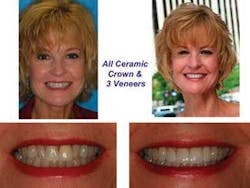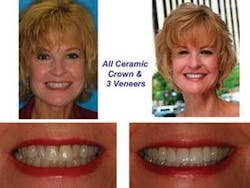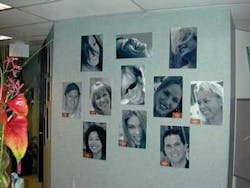Focus on Esthetic Dentistry
Creating a cosmetic practice within your general practice
Today’s dental practice is seeing increasing demand for cosmetic dental services. Additionally, many dentists are looking to expand their practices to provide more cosmetic services.
Seven years ago I purchased a general dental practice. It was a nice, successful, “typical” general dental practice, but it lacked a focus on cosmetic services. Before purchasing this practice, I had worked for more than five years with Dr. Ross Nash in his cosmetic practice in Charlotte, N.C. Having learned to enjoy the rewards of cosmetic dentistry and having the opportunity to learn from a true expert in the field, I was eager to move my newly purchased practice to a more cosmetically driven practice.
Over the course of seven years, the practice I purchased has gone from virtually zero elective dentistry to this year - when 54 percent of collections has come from elective and cosmetic dental production. Along the way, I have made many mistakes in trying to create my cosmetic practice, but I’d like to share the ideas that have worked. I hope some of them may assist your practice in moving to a more cosmetic-based practice.
Idea 1
From the first day in my new practice, my staff and I began to focus on bleaching. Existing patients were reminded that we offered bleaching services, and all new patients were informed about bleaching. Using medical history forms and medical history update forms, we looked to see if patients indicated an interest in whiter teeth, or if they listed discolored teeth as the chief complaint. If so, we’d always make time to discuss this with the patient.
Certainly, we want to help patients improve the appearance of their smiles. From a business standpoint, we make more money if we provide patients with bleaching services. Most important, patients who are interested in improving the color of their teeth are, at some level, concerned about their appearance. If they are concerned about their appearance, they may be interested in other cosmetic services. A discussion of bleaching can open the door to discussions of many other cosmetic dental options.
We also use bleaching as a marketing tool to help us find new patients who are esthetically driven. On occasion, we offer free take-home bleaching (Opalescence PF, Ultradent) to new patients through direct mailings or flyers. At local benefits, we offer in-office bleaching (Zoom!, Discus Dental) at silent auction tables. Bleaching has become the broad base on which we have built our cosmetic practice.
Idea 2
Initially, I had problems with my new staff in understanding how I wanted to create the cosmetic part of my practice. To help them better understand my concept, I asked them to think of the practice as having two front doors. On one door it reads, “Dr. Gary M. Radz, General Dentist.” On the other door it reads, “Cosmetic Dentistry of Colorado.” Then, as they received phone calls from potential new patients, they would need to decide which door the new patient would come through.
So, if the patient was looking for a place to have a cleaning, exam, or perhaps some fillings or crowns, he or she would be scheduled with “Dr. Gary M. Radz, General Dentist.” These patients would receive a one-hour appointment for a comprehensive exam, FMX, prophy, treatment plan, etc.
If the patient was calling to learn more about cosmetic or elective procedures, he or she would be coming through the “Cosmetic Dentistry of Colorado” door. These patients would be given a 30-minute consultation appointment, which is solely designed for the patient to sit and discuss with us the potential cosmetic options available.
By creating the imaginary two doors, the staff was now better able to envision the new focus of the practice. They also were now assigning the new patients to the appropriate time slots and procedures so that we served our patients’ needs better and we were more efficient with our time.
Idea 3
Immediately after purchasing the practice, we no longer provided amalgam restorations. My immediate goal was to create a more cosmetically focused practice. The use of amalgam in a cosmetically focused practice seemed hypocritical.
In today’s age of proven bonding agents and new, esthetic microhybrid composites (Premise/Kerr, EsthetX/Caulk, Venus/Heraeus Kulzer, Vitalessence/Ultradent, 4 Seasons/Ivoclar Vivadent, Filtek Supreme/3M ESPE), we can confidently restore teeth to look like teeth again. A large majority of the existing patients were very excited about the use of “tooth-colored” fillings, and we had excellent response and acceptance with this change in philosophy. Nevertheless, I always made a point to not disagree with the previous dentists’ treatment plans. Rather, I would explain that I wanted my patients to have teeth that looked like teeth, and that when carefully and properly placed, our newest composites could be every bit as good a restoration as amalgam.
To reinforce this to patients, we always demonstrate with digital photography. We photograph the tooth before and after the composite is placed to allow them to see that their new restoration is virtually invisible. Not only were the patients excited to have nonvisible restorations, they started to ask questions about replacing old, unesthetic restorations. They also began to tell others about their positive experience with the new “cosmetic” practice, and we immediately saw an increase in internal referrals.
This idea is an important step, whether you are buying a practice, starting a new practice, or have had your practice for many years. Initially, when trying to move in a more cosmetic direction, it will take awhile before you start attracting anterior elective cases. However, many patients need posterior restorative dentistry. Providing your existing patients with esthetic posterior restorative options will start to create the perception among your patients that you are interested in the appearance of their teeth and that you’re able to do “cosmetic” procedures. Then, not only are they more satisfied with the dentistry you provided, they are also more likely to refer potential patients to you.
Idea 4
Although I still feel strongly that gold is our best dental material, I will offer patients esthetic options. With the recent advent of zirconium-based crowns and bridges (Lava, 3M/ESPE, Cercon, Dentsply/Ceramco), we now have a highly esthetic and strong material that can provide patients with a nonmetal option that is strong enough for single-unit molar crowns as well as multiple-unit posterior bridges.
And even though I will always recommend gold on posterior teeth (especially second molars), I now have an excellent nonmetal esthetic option for patients who require full coverage on posterior teeth where previously I would only have considered PFM or gold.
Idea 5
I immediately invested in a digital camera and learned to use it in the practice. Today I cannot imagine not having my digital camera (Canon 20D, Norman Camera). It is my biggest educational and marketing tool. With it, I take before-and-after pictures of every anterior elective case that we complete, as well as many of the posterior cases. This allows me to do a number of marketing/educational projects that inform and promote the elective part of our practice.
THE BOOK - is a three-ring binder filled with many different examples of the types of elective procedures we offer (Figure 1). The book is used at the consultation appointment to demonstrate the ideas we have for improving patients’ smiles. By having numerous examples of many different cases, we can not only show them the variety of options we have, but they also nonverbally demonstrate to patients that we have a good deal of experience in this type of work.
THE WEB - The before-and-after pictures also are used on our Web site. This allows potential new patients to review the options available and demonstrate our experience in elective dentistry.
THE WALLS - In our office, the only artwork on the walls are before-and-after pictures of completed cases (Figure 2). We use this to show patients the potential that exists with cosmetic dentistry. It also has become a way to open conversations between patients and staff about cosmetic dentistry. Finally, it again reinforces that we have experience in cosmetic procedures. In effect, our walls of smiles have become a big “before-and-after” book (Figure 3).
I can’t emphasize enough the importance of digital photography. Cosmetic dentistry is a visual art form to patients. Demonstrating not only the changes that cosmetic dentistry can create, but also your ability and experience are very important to patients looking to make investments in elective care. There are many places to learn digital photography. I give credit to Drs. Tony Soileau and Tom Hedge, as well as the American Academy of Cosmetic Dentistry and the Academy of Comprehensive Esthetics for helping me significantly improve my photography.
Idea 6
A great return on investment is a well-done Web site. Many patients search the Internet for products and services, and elective dentistry is one of those items. A Web site gives you the opportunity to provide as much information as they could possibly want: the doctor’s bio, tour of the office, services provided, education on different aspects of dentistry, before-and-after photos, directions to the office, e-mail questions to the doctor, and so much more. It is a highly interactive way for potential patients to see if you are the right match for them.
Idea 7
MARKETING. Yes, like many of you, I thought this was a dirty word in dentistry. But the reality of our world today is that you need to market if you want to find potential new patients for cosmetic dentistry. We use only our own photography of our own patients when we create a marketing piece, and we make sure that when looking at the advertisement, it is obvious that this is a real cosmetic patient and that I was the photographer.
The ways you market your practice are dependent on where you live. Where I live in Denver, TV and radio are outside of my marketing budget. But in smaller markets, these tools can be affordable and successful. I have had success with print ads, flyers, and direct mail. But, much of marketing is trial and error, and repetition.
Idea 8
If you’re going to provide elective dentistry, you need to be well educated on the procedures and materials used in cosmetic dentistry. That means devotion to education beyond what we learned in dental school. I freely admit that in this area, I “cheated.” Dr. Nash is an icon in cosmetic dental education, and I had the benefit of a five-year “residency” working with him. But even then, I attended many of his courses to continue my learning, along with taking many more courses delivered by other talented dentists and ceramists - more than 1,000 during the past 12 years.
Aside from Dr. Nash, my mentors have been Larry Rosenthal, Ron Jackson, Buddy Mopper, Karl Leinfelder, Harold Heymann, Van Haywood, Peter Dawson, John Kois, Clayton Chan, Bill Dorfman, Dennis Wells, Bob Lowe, Jim Dunn, Pascal Mange, Bill Robbins, Bruce Crispin, Newton Fahl, Matt Roberts, Tom Trinkner, Bill Dickerson, and many more. Learning from a broad spectrum of ideas and opinions has given me a broad base of ideas to pull from, which eventually will help me be a better dentist.
Organized dentistry also has helped me advance my education. The American Academy of Cosmetic Dentistry (www.aacd.com) and the Academy of Comprehensive Esthetics (www.acesthetics.com) have been particularly influential.
They provide online learning, well-done journals, and scientific meetings that not only provide excellent education but have also allowed me to meet many other similarly motivated dentists to share ideas.
Continuing education is a significant part of creating a successful cosmetic practice. You can be the best marketing dentist in the world, but in the end, you need to “deliver the goods.” If you lack the required technical knowledge and ability, it will eventually catch up with you.
Idea 9
Create and write down your goals for your new “cosmetic” practice and share them with your team. If your existing team doesn’t share your enthusiasm for this new direction, don’t be afraid to find people who do share and promote your vision. The best thing I ever did for my office was dismiss staff members who were not interested in cosmetic dentistry and hire a new team that truly supports what I’m trying to do.
Although it is listed number 9, the number 1 most significant factor in changing my practice has been a wonderful team of women who not only completely support my vision of the practice, they make it their daily goal to market what we do because they know the impact it can have on people looking for cosmetic care.
The transition to, or the creation of a more cosmetic-based practice is challenging and does take time. But the rewards are so wonderful - from so many different aspects - that it is well worth the effort. Whether you are looking to make a big directional change in your practice or just wanting to increase the visibility of the cosmetic services you offer, I hope that by the time you’ve read this sentence you’ve found a few new ideas that can help you.Dr. Gary Radz maintains a full-time private practice in Denver, Colo. He is a clinical associate professor at the University of Colorado School of Dentistry. Dr. Radz recently received his fellowship from the Academy of Comprehensive Esthetics. He lectures internationally on the materials and techniques used in esthetic dentistry. Dr. Radz may be contacted at www.garyradz.com.



